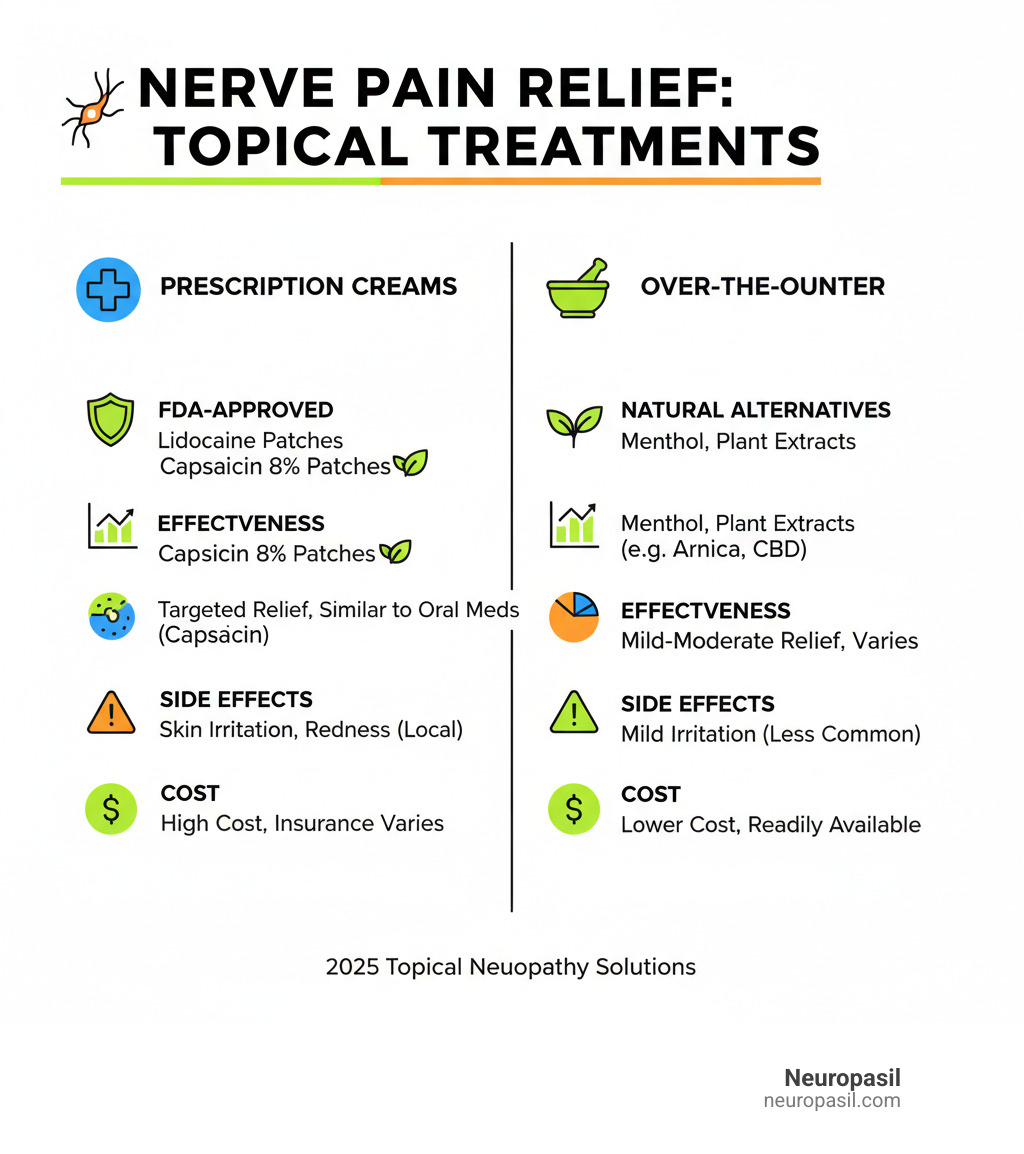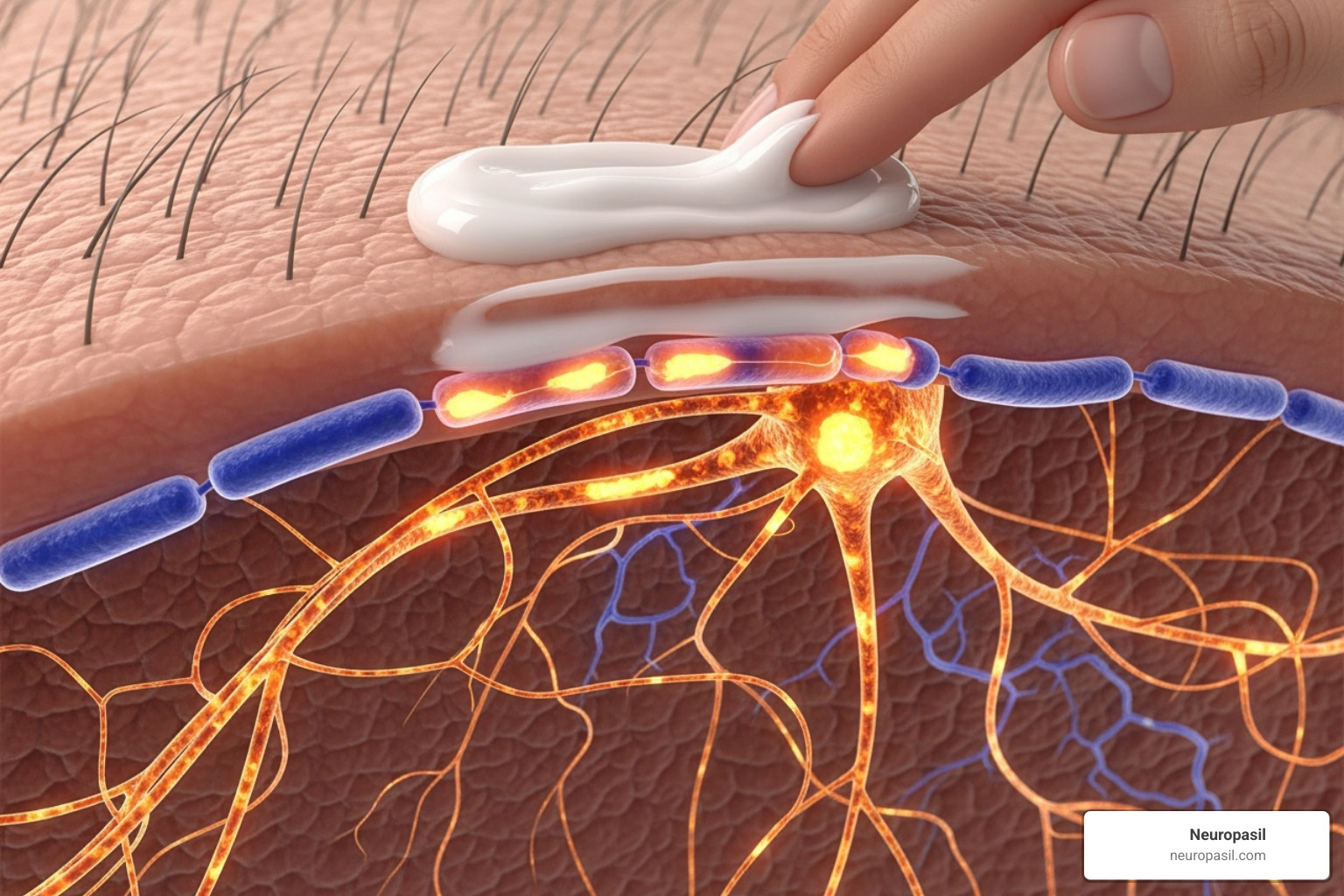The Growing Need for Effective Nerve Pain Relief
Nerve pain cream prescription options are increasingly sought after as people struggle with traditional oral medications. Neuropathic pain affects approximately 8% of US adults, yet only 40-60% of patients find adequate relief with standard treatments.
Quick Answer: Do Prescription Nerve Pain Creams Work?
- FDA-approved options: Only 3 prescription topical treatments exist (lidocaine 1.8%, lidocaine 5%, capsaicin 8% patches)
- Effectiveness: Capsaicin 8% patch shows similar efficacy to oral pregabalin
- Benefits: Targeted relief, fewer systemic side effects, minimal drug interactions
- Limitations: Limited research, high costs, insurance coverage issues
- Natural alternatives: Over-the-counter options like Neuropasil offer plant-based relief without prescription requirements
Many who try oral medications experience unwanted side effects like drowsiness and dizziness, leaving them caught between inadequate pain relief and a lower quality of life.
This is where topical treatments shine. Unlike oral drugs that affect your entire system, topical creams offer targeted local action with limited systemic availability. This makes them attractive for those seeking effective relief without the foggy thinking or fatigue common with oral medications.
The challenge is understanding which options work, what's available by prescription versus over-the-counter, and how to steer the complex landscape of nerve pain treatments.

Understanding Neuropathic Pain and Its Standard Treatments
Neuropathic pain is different from typical pain from an injury. It's caused by damage to the nervous system itself, which then sends faulty pain signals, like faulty electrical wiring in your body.
Common causes include:
- Diabetes: High blood sugar can damage nerve fibers over time, often starting in the feet and hands.
- Shingles: This can lead to post-herpetic neuralgia, a lingering burning or stabbing pain caused by nerve damage from the virus.
- Nerve injury: Accidents, surgery, or repetitive motions can trigger this type of pain.
For more details about what to watch for, check out our guide on Peripheral Neuropathy Symptoms.
Symptoms are often unmistakable and include a persistent burning sensation, shooting pain, tingling, or numbness that can make it hard to walk or handle small objects.
Doctors often start with oral medications. Antidepressants (like amitriptyline) and anticonvulsants (like gabapentin) can calm overactive nerve signals. The problem is that these medications travel through your entire body, leading to systemic side effects like dizziness, drowsiness, and brain fog. Drug-drug interactions are another concern, especially for those taking other medications.
The Challenge with Traditional Pain Management
The frustrating reality is that only 40% to 60% of people get meaningful relief from these oral medications. Many are left with partial pain relief while still dealing with side effects, which leads to patient adherence issues. When a medication makes you feel worse overall, it's hard to keep taking it.
Concerns about long-term use and the well-known opioid risks in pain management have created an urgent need for alternative therapies. This is why many are turning to nerve pain cream prescription options and other topical treatments. The idea of targeting pain directly, without flooding your system with medication, is a logical next step.
The Rise of Topical Treatments: Natural Nerve Pain Cream Options

When oral medications cause side effects, topical treatments offer a refreshing alternative. Instead of flooding your body with medication, you apply relief directly where it hurts.
The advantage of topical nerve pain treatments is their targeted local action. The active ingredients work at the source of discomfort with minimal systemic absorption, meaning they don't travel throughout your body causing unwanted effects.
This focused approach leads to fewer side effects and an improved safety profile, making topicals appealing for older adults, those on multiple medications, or anyone sensitive to oral drugs. A review on topical therapies for peripheral neuropathic pain confirms they offer targeted relief with limited systemic effects and fewer drug interactions.
Natural and Non-Prescription Topical Options
You don't always need a nerve pain cream prescription for effective relief. Natural and over-the-counter options offer accessible, plant-based solutions.
- Menthol, from peppermint oil, creates a cooling sensation that distracts nerves from pain signals.
- Capsaicin, from chili peppers, works by depleting the chemicals that send pain messages. High-strength capsaicin is prescription-only, but lower concentrations are available over-the-counter.
- Herbal extracts like arnica and turmeric are often included for their soothing, anti-inflammatory properties.
Natural topicals offer targeted relief with fewer systemic side effects, and many people prefer plant-based solutions. For those exploring these options, our guide on Nerve Pain Relief with Neuropasil provides more detail on how botanical ingredients can help.
How Topical Nerve Pain Creams Work

Topical treatments get straight to work at the skin level. The cooling or warming sensations from ingredients like menthol provide a distraction from pain, as your brain focuses on the new sensation instead of the underlying discomfort.
Other ingredients work by blocking pain signals directly, interfering with the abnormal nerve firing that causes neuropathic pain. Some compounds also support nerve health by reducing inflammation and soothing the skin.
The Role of Neuropasil in Nerve Pain Management
At Neuropasil, we believe effective nerve pain relief shouldn't require a prescription or cause significant side effects. Our natural formula uses carefully selected key ingredients for comprehensive nerve health support.
The formula is designed to provide targeted relief for burning, tingling, and numbness. Because Neuropasil relies on natural ingredients, it is suitable for daily use without the concerns associated with some long-term prescription medications. With no prescription required, you can start seeking relief without waiting for appointments or insurance approvals.
Topical vs. Oral Medications: A Head-to-Head Comparison
When choosing nerve pain relief, it's important to compare topical and oral medications. Both have their place, but they work differently. Here's how they stack up.
In terms of effectiveness, oral medications like gabapentin help about 40-60% of patients. They work well for widespread pain because they travel throughout the body.
Topical treatments excel at targeted relief for localized pain. The capsaicin 8% patch has shown non-inferior efficacy to oral pregabalin, meaning it works just as well. The lidocaine 5% patch also provides similar relief for certain conditions.
Side effects are where topicals really shine. Oral medications can cause systemic issues like dizziness, drowsiness, and fatigue that impact quality of life.
Topicals cause minimal systemic adverse events. Any local reactions like redness or itching are usually mild and temporary, giving them a better safety and tolerability profile. This makes them appealing for those sensitive to medications.
In terms of speed, oral medications can take days to weeks to show their full effect. Some topicals, like those with menthol or lidocaine, can start working in minutes. Capsaicin may take about two weeks for its full effect.
Drug interactions are another key difference. Oral neuropathic medications carry a significant risk of interacting with other drugs. Topicals have minimal risk of such interactions due to limited systemic absorption.
Given the choice, many patients prefer a topical agent over an oral pill. The reduced risk profile and fewer systemic side effects make topicals particularly attractive for elderly patients or anyone looking for effective relief with better tolerability.
Navigating Your Treatment: A Guide for Patients and Providers

Working with your healthcare provider can help you make informed decisions about nerve pain cream prescription options and over-the-counter alternatives.
Topical treatments are often best for people with localized pain in specific areas like the hands or feet. They are also a strong choice for those with liver or kidney issues or who take multiple medications, as topicals don't add stress to internal organs. Many patients simply prefer applying relief directly to the skin.
However, cost and access barriers can be a challenge. Compounded and prescription topicals can be expensive with spotty insurance coverage, even in cities like New York. Over-the-counter options provide a more accessible way to experience topical relief without these problems.
Choosing the Right Topical Treatment
Picking the right topical depends on your pain type and body.
- For allodynia (pain from light touch), lidocaine patches can create a numbing barrier that makes contact with clothing tolerable.
- For spontaneous pain like burning or electric shocks, capsaicin can be effective by gradually desensitizing nerve endings.
Your individual patient factors are crucial. Test a small patch first if you have sensitive skin. Also, consider your lifestyle—some creams require multiple daily applications, while patches can be worn for longer. For deep nerve pain like Sciatica Pain, topicals can help with surface-level discomfort as part of a broader treatment plan.
The Role of Your Healthcare Provider in Managing Nerve Pain
Your doctor is your partner in navigating nerve pain management. A proper diagnosis is the first step, as different pain types respond to different treatments. When you meet, be prepared to:
- Describe your pain: Is it burning, shooting, or tingling? What makes it better or worse?
- Discuss treatment goals: Success might mean sleeping through the night or reducing pain intensity by half. Clear goals help your provider tailor your treatment.
- Follow application instructions: Details like how much to apply and how often can make or break your success.
- Watch for adverse effects: While generally mild, local reactions like redness, itching, or burning can occur. Know when a reaction is normal versus when to call your doctor.
Future of Topical Neuropathy Treatments
The future of topical nerve pain treatment is promising. Researchers are exploring new natural formulations that combine plant-based ingredients for more powerful and tolerable relief. Improved delivery systems, like long-acting patches or deeper-penetrating creams, are also on the horizon.
Research on plant-based ingredients like cannabinoids and other herbal extracts is particularly intriguing, though still in early stages. However, we need more clinical trials to build robust evidence for many topical treatments, especially compounded medications. This continuous evolution means more diverse, effective, and personalized options are on the way.
Frequently Asked Questions about Nerve Pain Creams
Here are answers to some of the most common questions about nerve pain creams, whether you're considering a nerve pain cream prescription or a natural alternative.
How long does it take for nerve pain cream to work?
The time it takes to feel relief depends on the active ingredients and your body's response.
- Instant Relief: Creams with menthol or lidocaine can provide a cooling or numbing sensation within minutes.
- Gradual Relief: Capsaicin creams require more patience. The full pain-relieving benefit often takes about two weeks of consistent daily use.
- Natural Creams: With formulations like Neuropasil, many people notice improvement within days to weeks of regular, consistent application. Don't give up too quickly, as the best results come with routine use.
Are there over-the-counter alternatives to prescription creams?
Yes, and they offer a convenient and often more affordable option for relief.
- Lidocaine: While prescriptions come in 1.8% or 5% strengths, you can find effective OTC creams with up to 4% lidocaine for temporary numbing.
- Capsaicin: High-potency 8% patches are prescription-only, but gentler OTC versions (0.025% or 0.075%) are available on pharmacy shelves.
- Natural Options: Products like Neuropasil use ingredients like menthol and herbal extracts to provide relief without synthetic compounds. Many people prefer this plant-based approach.
OTC options are typically gentler but more accessible and carry fewer risks. Always check the ingredient list to ensure quality.
Can I use topical creams for sciatic nerve pain?
Sciatica is tricky because the nerve runs deep from your lower back down your leg. For more on this condition, see our guide on Sciatic Nerve Pain.
Topical creams cannot reach the deep sciatic nerve itself to fix the root problem. However, if your sciatica causes surface-level symptoms like burning or tingling on your skin, creams can provide significant comfort by soothing irritated nerve endings in that area.
Think of topicals as one tool in a comprehensive plan that may include physical therapy and other treatments. Always consult your doctor when dealing with sciatica to create a plan that addresses your specific situation.
Conclusion
Navigating neuropathic pain is easier with the right information. As we've seen, nerve pain cream prescription options and natural alternatives offer new hope for those limited by oral medications.
Topical treatments are an important tool in pain management because they offer targeted action with a favorable side-effect profile. This means you can get relief without the systemic side effects like drowsiness or fatigue common with oral drugs. The ability to provide relief without disrupting daily life is a significant advantage.
Empowering patients with knowledge is key. By working with your healthcare provider, you can make a collaborative decision that you feel good about. You know your body best, and combining that insight with professional guidance leads to the best outcomes.
At Neuropasil, we focus on natural solutions that work with your body. Our formulas are crafted based on research into how plant-based ingredients can support nerve health and provide gentle, effective relief. We believe everyone deserves access to safe, natural options that don't require a prescription.
The future of nerve pain management is moving toward a more targeted, gentler approach. Your journey to better nerve health starts with taking the first step. Find out how our natural solutions can become part of your path to comfort with Nerve Pain Relief with Neuropasil.













